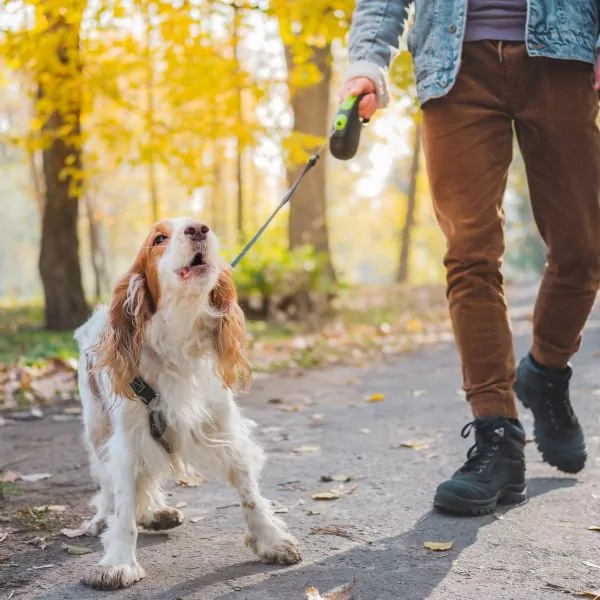Walking your dog can be a fun and rewarding experience – for both you and your pup! But if your pooch is reactive, it can quickly become an overwhelming situation. To help make sure that walks are enjoyable for all involved, here are some tips to keep in mind when walking a reactive dog. From ensuring that they have plenty of space to teaching them how to focus on the task at hand, these steps will help ensure that each outing is positive and stress-free.
And for extra help in between walks, consider introducing your pup to calm, supervised environments like group-based dog settings where they can build confidence in structured social settings.
Understanding Reactivity in Dogs: Identifying Triggers and Supportive Behavior
When walking a reactive dog, understanding their behaviour and identifying triggers is essential for a pleasant experience. Reactive dogs may display a range of behaviours, such as barking, lunging, or growling, which can be alarming and stressful for both the dog and the owner. The key to managing a reactive dog is recognizing their trigger situations and providing support to help them feel more at ease during walks.
Reactive behaviour may vary from one dog to another, but common triggers include other dogs, unfamiliar people, loud noises, or sudden movements. As a pet owner, observing your dog’s reactions to various situations can help to identify specific triggers and tailor your pet care strategies accordingly. It is also crucial to note any changes in your dog’s health, as illnesses or discomfort may exacerbate reactive tendencies.
Once you have identified your reactive dog’s triggers, you can work on creating a more supportive environment during walks. This may involve adjusting the time or route of your walks to avoid particularly busy or noisy areas, allowing your dog to slowly acclimate to new experiences. It’s also important to consider the role that your dog’s breed plays in their behaviour, as some breeds may be more prone to reactive tendencies than others.
Another crucial aspect of understanding reactive dogs is recognizing your role as the owner in supporting and managing their behaviour. Consistency in training and care is crucial for helping reactive dogs feel safe and secure during walks. Working with a professional dog trainer can be invaluable in learning effective techniques and strategies for managing your dog’s reactivity and ensuring their long-term health and well-being. Another option is to contact a professional dog walker who can work with your reactive dog.
And if you’re seeking structured support beyond training sessions, a trusted dog care facility can provide a calming space that reinforces positive behaviour through routine and gentle exposure.
In summary, the key to walking a reactive dog lies in understanding their behaviour, triggers, and the support required to create enjoyable walks. By adjusting walking routines, providing consistent training and care, and seeking help from professionals such as Jon Zeller the “Dog Walking Farmer,” pet owners can help their reactive dog develop more confidence and ultimately enjoy a more fulfilling, stress-free walking experience. With patience and understanding, walking a reactive dog can become a joyful bonding experience for both the owner and their four-legged friend.
Whether through consistent home practice or professional guidance from dog walking programs, even the most anxious pups can learn to walk with more ease.
Proactive Steps for Walking Reactive Dogs: Techniques and Consistency
Walking a reactive dog can be challenging, but with a few proactive steps and consistent techniques, you can make your daily walks enjoyable for both you and your canine companion. Understanding leash reactivity and knowing how to manage your dog’s behaviour is crucial for a successful and stress-free walk.
First, identify the triggers that cause your dog’s reactive behaviour. This could be anything from big dogs to fresh food on the ground or even a specific person. By recognizing the things that set off your pet’s reactions, you can better prepare for, and manage, various situations that arise while out walking.
Before you head out on a walk, make sure your dog’s health and overall well-being are being supported. Regular check-ups with your vet and fresh, quality food can go a long way in preventing potential reactivity issues.
When it comes to reactive dog training, consistency is key. Make sure to follow a consistent training plan and use the same commands each time. Reinforce good behavior through rewards and positive reinforcement, while also ensuring that you and your dog develop trust and understanding.
Consider working with a professional dog trainer if you feel like you need additional support in managing your dog’s reactive behaviour. A qualified dog trainer can provide personalized training plans and guidance that will greatly benefit you and your dog’s walk.
One useful technique to try is teaching your dog an alternative behaviour as a response to their trigger. For example, if your reactive dog tends to bark at big dogs during walks, try teaching them to “turn” or “drop” on command, redirecting their attention away from the trigger and focusing on you instead.
Sometimes, even with proactive measures and consistent training, reactive dogs may still struggle in certain situations. In these cases, it’s important to practice patience and remain calm, understanding that improvements may take time. Continuing your efforts will show your pet that they have your support and encouragement throughout the process.
Lastly, never underestimate the power of proper management when it comes to walking reactive dogs. Anticipate potential problems, plan your route accordingly, and always have a backup plan in case things don’t go as intended. For long-term support, some dogs may benefit from occasional breaks or care through premium care options for dogs that offer customized environments for emotional and behavioural growth. By doing so, you’ll help ensure that both you and your dog have an enjoyable experience while out on your walks together.
If you’re looking for more dog walking tips, here is an article on walking your dog on rainy days.
